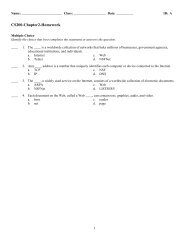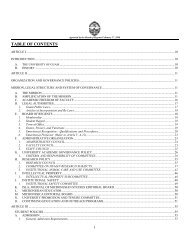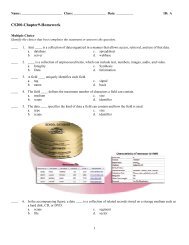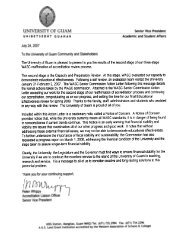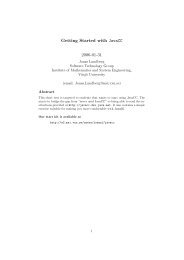Semantic Errors
Semantic Errors
Semantic Errors
You also want an ePaper? Increase the reach of your titles
YUMPU automatically turns print PDFs into web optimized ePapers that Google loves.
CompilersCS414-2006S-06<strong>Semantic</strong> AnalysisDavid GallesDepartment of Computer ScienceUniversity of San Francisco
06-0: Syntax <strong>Errors</strong>/<strong>Semantic</strong> <strong>Errors</strong>A program has syntax errors if it cannot begenerated from the Context Free Grammar whichdescribes the languageThe following code has no syntax errors, though ithas plenty of semantic errors:void main() {if (3 + x - true)x.y.z[3] = foo(z);}Why don’t we write a CFG for the language, so thatall syntactically correct programs also contain nosemantic errors?
06-2: JavaCC & CFGsJavaCC allows actions – arbitrary Java code – inrulesWe could use JavaCC rules to do type checkingWhy don’t we?
06-3: JavaCC & CFGsJavaCC allows actions – arbitrary Java code – inrulesWe could use JavaCC rules to do type checkingWhy don’t we?JavaCC files become very long, hard to follow,hard to debugNot good software engineering – trying to dotoo many things at once
06-4: <strong>Semantic</strong> <strong>Errors</strong>/Syntax <strong>Errors</strong>Thus, we only build the Abstract Syntax Tree inJavaCC (not worrying about ensuring thatvariables are declared before they are used, or thattypes match, and so on)The next phase of compilation – <strong>Semantic</strong> Analysis– will traverse the Abstract Syntax Tree, and findany semantic errors – errors in the meaning(semantics) of the program<strong>Semantic</strong> errors are all compile-time errors otherthan syntax errors.
06-5: <strong>Semantic</strong> <strong>Errors</strong><strong>Semantic</strong> <strong>Errors</strong> can be classified into the followingbroad categories:Definition <strong>Errors</strong>Most strongly typed languages require variables,functions, and types to be defined before they areused with some exceptions –Implicit variable declarations in FortranImplicit function definitions in C
06-6: <strong>Semantic</strong> <strong>Errors</strong><strong>Semantic</strong> <strong>Errors</strong> can be classified into the followingbroad categories:Structured Variable <strong>Errors</strong>x.y = A[3]x needs to be a class variable, which has aninstance variable yA needs to be an array variablex.y[z].w = 4x needs to be a class variable, which has aninstance variable y, which is an array of classvariables that have an instance variable w
06-7: <strong>Semantic</strong> <strong>Errors</strong><strong>Semantic</strong> <strong>Errors</strong> can be classified into the followingbroad categories:Function and Method <strong>Errors</strong>foo(3, true, 8)• foo must be a function which takes 3parameters:• integer• boolean• integer
06-8: <strong>Semantic</strong> <strong>Errors</strong><strong>Semantic</strong> <strong>Errors</strong> can be classified into the followingbroad categories:Type <strong>Errors</strong>Build-in functions – /, *, ||, &&, etc. – need to becalled with the correct typesIn simpleJava, +, -, *, / all take integersIn simpleJava, || &&, ! take booleansStandard Java has polymorphic functions &type coercion
06-9: <strong>Semantic</strong> <strong>Errors</strong><strong>Semantic</strong> <strong>Errors</strong> can be classified into the followingbroad categories:Type <strong>Errors</strong>Assignment statements must have compatibletypesWhen are types compatible?
06-10: <strong>Semantic</strong> <strong>Errors</strong><strong>Semantic</strong> <strong>Errors</strong> can be classified into the followingbroad categories:Type <strong>Errors</strong>Assignment statements must have compatibletypesIn Pascal, only Identical types are compatible
06-11: <strong>Semantic</strong> <strong>Errors</strong><strong>Semantic</strong> <strong>Errors</strong> can be classified into the followingbroad categories:Type <strong>Errors</strong>Assignment statements must have compatibletypesIn C, types must have the same structureCoerceable types also applystruct { struct {int x; int z;char y; char x;} var1; } var2;
06-12: <strong>Semantic</strong> <strong>Errors</strong><strong>Semantic</strong> <strong>Errors</strong> can be classified into the followingbroad categories:Type <strong>Errors</strong>Assignment statements must have compatibletypesIn Object oriented languages, can assignsubclass value to a superclass variable
06-13: <strong>Semantic</strong> <strong>Errors</strong><strong>Semantic</strong> <strong>Errors</strong> can be classified into the followingbroad categories:Access Violation <strong>Errors</strong>Accessing private / protected methods /variablesAccessing local functions in block structuredlanguagesSeparate files (C)
06-14: EnvironmentMuch of the work in semantic analysis is managingenvironmentsEnvironments store current definitions:Names (and structures) of typesNames (and types) of variablesNames (and return types, and number andtypes of parameters) of functionsAs variables (functions, types, etc) are declared,they are added to the environment. When avariable (function, type, etc) is accessed, itsdefinition in the environment is checked.
void main() {foo foo;foo = new foo();foo.foo = 4;print(foo.foo);}06-15: Environments & Name SpacesTypes and variables have different name spaces insimpleJava, C, and standard Java:simpleJava:class foo {int foo;}
06-16: Environments & Name SpacesTypes and variables have different name spaces insimpleJava, C, and standard Java:C:#include typedef int foo;int main() {foo foo;foo = 4;printf("%d", foo);return 0;}
06-17: Environments & Name SpacesJava:Types and variables have different name spaces insimpleJava, C, and standard Java:class EnviornTest {static void main(String args[]) {}}Integer Integer = new Integer(4);System.out.print(Integer);
06-18: Environments & Name SpacesVariables and functions in C share the same namespace, so the following C code is not legal:int foo(int x) {return 2 * x;}int main() {int foo;printf("%d\n",foo(3));return 0;}The variable definition int foo; masks thefunction definition for foo
06-19: Environments & Name SpacesBoth standard Java and simpleJava use differentname spaces for functions and variablesDefining a function and variable with the samename will not confuse Java or simpleJava in thesame way it will confuse CProgrammer might still get confused ...
06-20: simpleJava EnvironmentsWe will break simpleJava environment into 3 parts:type environment Class definitions, andbuilt-in types int, boolean, and void.function environment Function definitions –number and types of input parameters and thereturn typevariable environment Definitions of localvariables, including the type for each variable.
06-21: Changing Environmentsint foo(int x) {boolean y;x = 2;y = false;/* Position A */{ int y;boolean z;y = 3;z = true;/* Position B */}/* Position C */
06-22: Implementing EnvironmentsEnvironments are implemented with Symbol TablesSymbol Table ADT:Begin a new scope.Add a key / value pair to the symbol tableLook up a value given a key. If there are twoelements in the table with the same key, returnthe most recently entered value.End the current scope. Remove all key / valuepairs added since the last begin scopecommand
06-23: Implementing Symbol TablesImplement a Symbol Table as a listInsert key/value pairs at the front of the listSearch for key/value pairs from the front of thelistInsert a special value for “begin new scope”For “end scope”, remove values from the frontof the list, until a “begin scope” value is reached
06-24: Implementing Symbol Tablesybooleanxintazynewscopeyxbooleanintbooleanintbybooleanxintc
06-25: Implementing Symbol TablesImplement a Symbol Table as an open hash tableMaintain an array of lists, instead of just oneStore (key/value) pair in the front oflist[hash(key)], where hash is a functionthat converts a key into an indexIf:The hash function distributes the keys evenlythroughout the range of indices for the list# number of lists = Θ(# of key/value pairs)Then inserting and finding take time Θ(1)
06-26: Hash Functionslong hash(char *key, int tableSize) {long h = 0;long g;for (;*key;key++) {h = (h > 24h &= g}return h % tableSize;}
06-27: Implementing Symbol TablesWhat about beginScope and endScope?The key/value pairs are distributed across severallists – how do we know which key/value pairs toremove on an endScope?
06-28: Implementing Symbol TablesWhat about beginScope and endScope?The key/value pairs are distributed across severallists – how do we know which key/value pairs toremove on an endScope?If we knew exactly which variables wereinserted since the last beginScope command,we could delete them from the hash tableIf we always enter and remove key/value pairsfrom the beginning of the appropriate list, wewill remove the correct items from theenvironment when duplicate keys occur.How can we keep track of which keys havebeen added since the last beginScope?
06-29: Implementing Symbol TablesHow can we keep track of which keys have beenadded since the last beginScope?Maintain an auxiliary stackWhen a key/value pair is added to the hashtable, push the key on the top of the stack.When a “Begin Scope” command is issued,push a special begin scope symbol on thestack.When an “End scope” command is issued, popkeys off the stack, removing them from the hashtable, until the begin scope symbol is popped
06-30: Type CheckingBuilt-in types ints, floats, booleans, doubles,etc. simpleJava only has the built-in types int andbooleanStructured types Collections of other types –arrays, records, classes, structs, etc. simpleJavahas arrays and classesPointer types int *, char *, etc. Neither Java norsimpleJava have explicit pointers – no pointer type.(Classes are represented internally as pointers, noexplicit representation)Subranges & Enumerated Types C andPascal have enumerated types (enum), Pascal hassubrange types. Java has neither (at least currently
06-31: Built-In TypesNo auxiliary information required for built-in typesint and boolean (an int is and int is an int)All types will be represented by pointers to typeobjectsWe will only allocate one block of memory for allinteger types, and one block of memory for allboolean types
06-32: Built-In Typesvoid main() {int x;int y;boolean a;boolean b;}x = y;x = a; /* Type Error */
06-33: Built-In TypesType EnvironmentKeyStackintbooleanvoidintbooleanvoidINTEGERTYPEBOOLEANTYPEVOIDTYPEnewscopeKeyStackxyabbayxVariable Environmentnewscope
06-34: Class TypesFor built-in types, we did not need to store anyextra information.For Class types, what extra information do weneed to store?
06-35: Class TypesFor built-in types, we did not need to store anyextra information.For Class types, what extra information do weneed to store?The name and type of each instance variableHow can we store a list of bindings of variables totypes?
06-36: Class TypesFor built-in types, we did not need to store anyextra information.For Class types, what extra information do weneed to store?The name and type of each instance variableHow can we store a list of bindings of variables totypes?As an environment!
06-37: Class Typesclass simpleClass {int x;int y;boolean z;}void main() {simpleClass a;simpleClass b;int c;int d;}a = new simpleClass();a.x = c;
06-38: Class TypesType Enviornment:KeyStacksimpleClasssimpleClassbooleanvoidvoidbooleanintBOOLEANTYPEVOIDTYPEintnewscopeINTEGERTYPECLASS TYPEKeyStackzxyzyxKeyStackcdbadcbaVariable Environmentnewscope
06-39: Array TypesFor arrays, what extra information do we need tostore?
06-40: Array TypesFor arrays, what extra information do we need tostore?The base type of the arrayFor statically declared arrays, we might alsowant to store range of indices, to add rangechecking for arraysWill add some run time inefficiency – need toadd code to dynamically check each arrayaccess to ensure that it is within the correctboundsLarge number of attacks are based on bufferoverflows
06-41: Array TypesMuch like built-in types, we want only one instanceof the internal representation for int[], onerepresentation for int[][], and so onSo we can do a simple pointer comparison todetermine if types are equalOtherwise, we would need to parse an entiretype structure whenever a type comparisonneeded to be done (and type comparisons needto be done frequently in semantic analysis!)
06-42: Array Typesvoid main () {int w;int x[];int y[];int z[][];}/* Body of main program */
06-43: Class TypesType EnvironmentKeyStackintint[]booleanvoidint[][]int[][]int[]intINTEGERTYPEBOOLEANTYPEVOIDTYPEbooleanARRAY TYPEARRAY TYPEvoidnewscopeKeyStackwyxzzyxwVariable Environmentnewscope
06-44: <strong>Semantic</strong> Analysis OverviewA <strong>Semantic</strong> Analyzer traverses the Abstract SyntaxTree, and checks for semantic errorsWhen declarations are encountered, propervalues are added to the correct environment
06-45: <strong>Semantic</strong> Analysis OverviewA <strong>Semantic</strong> Analyzer traverses the Abstract SyntaxTree, and checks for semantic errorsWhen a statement is encountered (such as x =3), the statement is checked for errors using thecurrent environmentIs the variable x declared in the currentscope?Is it x of type int?
06-46: <strong>Semantic</strong> Analysis OverviewA <strong>Semantic</strong> Analyzer traverses the Abstract SyntaxTree, and checks for semantic errorsWhen a statement is encountered (such as if (x> 3) x++;), the statement is checked for errorsusing the current environmentIs the expression x > 3 a valid expression(this will require a recursive analysis of theexpression x > 3)Is the expression x > 3 of type boolean?Is the statement x++ valid (this will require arecursive analysis of the statement x++;
06-47: <strong>Semantic</strong> Analysis OverviewA <strong>Semantic</strong> Analyzer traverses the Abstract SyntaxTree, and checks for semantic errorsWhen a function definition is encountered:Begin a new scopeAdd the parameters of the functions to thevariable environmentRecursively check the body of the functionEnd the current scope (removing definitionsof local variables and parameters from thecurrent environment)
06-48: Variable Declarationsint x;Look up the type int in the type environment.(if it does not exists, report an error)Add the variable x to the current variableenvironment, with the type returned from thelookup of int
06-49: Variable Declarationsfoo x;Look up the type foo in the type environment.(if it does not exists, report an error)Add the variable x to the current variableenvironment, with the type returned from thelookup of foo
06-50: Array Declarationsint A[];Defines a variable AAlso potentially defines a type int[]
06-51: Array Declarationsint A[];look up the type int[] in the type environmentIf the type exists:Add A to the variable environment, with thetype returned from looking up int[]
06-52: Array Declarationsint A[];look up the type int[] in the type environmentIf the type does not exist:Check to see ifint appears in the typeenvironment. If it does not, report an errorIf int does appear in the type environment• Create a new Array type (using the typereturned from int as a base type)• Add new type to type environment, withkey int[]• Add variable A to the variable environment,with this type
06-53: Multidimensional ArraysFor multi-dimensional arrays, we may need torepeat the processFor a declaration int x[][][], we may need to add:int[]int[][]int[][][]to the type environment, before adding x to thevariable environment with the type int[][][]
06-54: Multidimensional Arraysvoid main() {int A[][][];int B[];int C[][];}/* body of main */For A[][][]:Add int[], int[][], int[][][] to type environmentadd A to variable environment with type int[][][]
06-55: Multidimensional Arraysvoid main() {int A[][][];int B[];int C[][];}/* body of main */For B[]:int[] is already in the type environment.add B to variable environment, with the typefound for int[]
06-56: Multidimensional Arraysvoid main() {int A[][][];int B[];int C[][];}/* body of main */For C[][]:int[][] is already in the type environmentadd C to variable environment with type foundfor int[][]
06-57: Multidimensional ArraysFor the declaration int A[][][], why add typesint[], int[][], and int[][][] to the type environment?Why not just create a type int[][][], and add A to thevariable environment with this type?In short, why make sure that all instances of thetype int[] point to the same instance?(examples)
06-58: Multidimensional Arraysvoid Sort(int Data[]);void main() {int A[];int B[];int C[][];/* Code to allocate space for A,B & C, andset initial values */}Sort(A);Sort(B);Sort(C[2]);
06-59: Function Prototypesint foo(int a, boolean b);Add a description of this function to the functionenvironment
06-60: Function Prototypesint foo(int a, boolean b);Add a description of this function to the functionenvironmentType of each parameterReturn type of the function
06-61: Function Prototypesint foo(int a, boolean b);Type EnvironmentKeyStackintbooleanvoidintbooleanvoidINTEGERTYPEBOOLEANTYPEVOIDTYPEnewscopeFUNCTION TYPEKeyStackfoofooReturn TypeParametersnewscopeFunction Environment
06-62: Function Prototypesint PrintBoard(int board[][]);Analyze types of input parameterAdd int[] and int[][] to the type environment, ifnot already there.
06-63: Class Definitionsclass MyClass {int integerval;int Array[];boolean boolval;}
06-64: Class Definitionsclass MyClass {int integerval;int Array[];boolean boolval;}Create a new variable environment
06-65: Class Definitionsclass MyClass {int integerval;int Array[];boolean boolval;}Create a new variable environmentAdd integerval, Array, and boolval to thisenvironment (possibly adding int[] to the typeenvironment)
06-66: Class Definitionsclass MyClass {int integerval;int Array[];boolean boolval;}Create a new variable environmentAdd integerval, Array, and boolval to thisenvironment (possibly adding int[] to the typeenvironment)Add entry in type environment with key MyClassthat stores the new variable environment
06-67: Function PrototypesType Enviornment:KeyStackMyClassint int[] boolean voidMyClassvoidbooleanINTEGERTYPEARRAYTYPEBOOLEANTYPEVOIDTYPEintnewscopeCLASS TYPEKeyStackzboolvalintegervalArrayyx
06-68: Function DefinitionsAnalyze formal parameters & return type. Checkagainst prototype (if there is one), or add functionentry to function environment (if no prototype)Begin a new scope in the variable environmentAdd formal parameters to the variable environmentAnalyze the body of the function, using modifiedvariable environmentEnd current scope in variable environment
06-69: ExpressionsTo analyze an expression:Make sure the expression is well formed (nosemantic errors)Return the type of the expression (to be usedby the calling function)
06-70: ExpressionsSimple Expressions3 (integer literal)This is a well formed expression, with thetype inttrue (boolean literal)This is a well formed expression, with thetype int
06-71: ExpressionsOperator Expressions3 + 4Recursively find types of left and rightoperandMake sure the operands have integer typesReturn integer typex > 3Recursively find types of left and rightoperandMake sure the operands have integer typesReturn boolean type
06-72: ExpressionsOperator Expressions(x > 3) || zRecursively find types of left and rightoperandMake sure the operands have boolean typesReturn boolean type
06-73: Expressions – VariablesSimple (Base) Variables – xLook up x in the variable environmentIf the variable was in the variable environment,return the associated type.If the variable was not in the variableenvironment, display an error.Need to return something if variable is notdefined – return type integer for lack ofsomething better
06-74: Expressions – VariablesArray Variables – A[3]Analyze the index, ensuring that it is of type intAnalyze the base variable. Ensure that thebase variable is an Array TypeReturn the type of an element of the array,extracted from the base type of the arrayint A[];/* initialize A, etc. */x = A[3];
06-75: Expressions – VariablesArray VariablesAnalyze the index, ensuring that it is of type intAnalyze the base variable. Ensure that thebase variable is an Array TypeReturn the type of an element of the array,extracted from the base type of the arrayint B[][];/* initialize B, etc. */x = B[3][4];
06-76: Expressions – VariablesArray VariablesAnalyze the index, ensuring that it is of type intAnalyze the base variable. Ensure that thebase variable is an Array TypeReturn the type of an element of the array,extracted from the base type of the arrayint B[][];int A[];/* initialize A, B, etc. */x = B[A[4]][A[3]];
06-77: Expressions – VariablesArray VariablesAnalyze the index, ensuring that it is of type intAnalyze the base variable. Ensure that thebase variable is an Array TypeReturn the type of an element of the array,extracted from the base type of the arrayint B[][];int A[];/* initialize A, B, etc. */x = B[A[4]][B[A[3],A[4]]];
06-78: Expressions – VariablesInstance Variables – x.yAnalyze the base of the variable (x), and makesure it is a class variable.Look up y in the variable environment for theclass xReturn the type associated with y in thevariable environment for the class x.
06-79: Instance Variablesclass foo {int x;boolean y;}int main() {foo x;int y;...y = x.x;y = x.y;}Complete example: Create Type Env, Show AST, Cover Analysis
06-80: Instance Variablesclass foo {int x;boolean y[];}int main() {foo A[];int a;boolean b;...w = A[3].x;b = A[3].y[4];b = A[3].y[A[3].x];}
06-81: StatementsIf statementsAnalyze the test, ensure that it is of typebooleanAnalyze the “if” statementAnalyze the “else” statement (if there is one)
06-82: StatementsAssignment statementsAnalyze the left-hand side of the assignmentstatementAnalyze the right-hand side of the assignmentstatementMake sure the types are the sameCan do this with a simple pointer comparison!
06-83: StatementsBlock statementsBegin new scope in variable environmentRecursively analyze all childrenEnd current scope in variable environment
06-84: StatementsVariable Declaration StatementsLook up type of variableMay involve adding types to typeenvironment for arraysAdd variable to variable environmentIf there is an initialization expression, makesure the type of the expression matches thetype of the variable.
06-85: Types in JavaEach type will be represented by a classAll types will be subclasses of the “type” class:class Type { }
06-86: Built-in TypesOnly one internal representation of each built-intypeAll references to INTEGER type will be apointer to the same block of memoryHow can we achieve this in Java?Singleton software design pattern
06-87: Singletons in JavaUse a singleton when you want only oneinstantiation of a classEvery call to “new” creates a new instance– prohibit calls to “new”!Make the constructor privateObtain instances through a static method
06-88: Singletons in Javapublic class IntegerType extends Type {private IntegerType() { }}public static IntegerType instance() {if (instance_ == null) {instance_ = new IntegerType();}return instance_;}static private IntegerType instance_;
06-89: Singletons in JavaType t1;Type t2;Type t3;t1 = IntegerType.instance();t2 = IntegerType.instance();t3 = IntegerType.instance();t1, t2, and t3 all point to the same instance
06-90: Structured Types in JavaBuilt-in types (integer, boolean, void) do not needany extra information)An integer is an integer is an integerStructured types (Arrays, classes) need moreinformationAn array of whatWhat fields does the class have
06-91: Array Types in JavaInternal representation of array type needs to storethe element type of the arrayclass ArrayType extends Type {public ArrayType(Type type) {type_ = type;}public Type type() {return type_;}public void settype(Type type) {type_ = type;}}private Type type_;
06-92: Array Types in JavaCreating the internal representation of an array ofintegers:Type t1;t1 = new ArrayType(IntegerType.instance());Creating the internal representation of a 2D arrayof integers:Type t2;t2 = new ArrayType(new ArrayType(IntegerType.instance()));
06-93: Array Types in JavaCreating the internal representation of a 2D arrayof integers:Type t2;t2 = new ArrayType(new ArrayType(IntegerType.instance()));Note that you should not use this exact code inyour semantic analyzerCreate a 1D array of integers, add this to thetype environmentCreate an array of 1D array of integers, usingthe previously created type
06-94: EnvironmentsTypeEnvironment.javaTypeEntry.javaVariableEnvironment.javaVariableEntry.javaFunctionEnvironment.javaFunctionEntry.Java
06-95: Class TypesCreate the type for the class:class foo {int x;boolean y;}with the Java code:Type t4;VariableEnviornment instanceVars = new VariableEnviornment();instancevars.insert("x", new VariableEntry(IntegerType.instance()));instancevars.insert("y", new VariableEntry(BooleanType.instance()));t4 = new ClassType(instanceVars);
06-96: Reporting <strong>Errors</strong>Class CompError:public class CompError {private static int numberOf<strong>Errors</strong> = 0;public static void message(int linenum, String errstm) {numberOf<strong>Errors</strong>++;System.out.println("TstError in line " + linenum + ": "+ errstm);}public static boolean any<strong>Errors</strong>() {return numberOf<strong>Errors</strong> > 0;}}public static int numberOf<strong>Errors</strong>() {return numberOf<strong>Errors</strong>;}
06-97: Reporting <strong>Errors</strong>Using CompErrorTrying to add booleans on line 12 ...CompError.message(12, "Arguments to + must be integers");
06-98: Traversing the ASTWrite a Visitor to do <strong>Semantic</strong> AnalysisMethod for each type of AST nodeVisitProgram analyzes ASTprogramVisitIfStatement analyzes an ASTstatement... etc.
06-99: Setting up the Visitorpublic class <strong>Semantic</strong>Analyzer implements ASTVisitor {private VariableEnvironment variableEnv;private FunctionEnvironment functionEnv;private TypeEnvironment typeEnv;/* May need to add some more ... */public <strong>Semantic</strong>Analyzer() {variableEnv = new VariableEnvironment();functionEnv = new FunctionEnvironment();functionEnv.addBuiltinFunctions();typeEnv = new TypeEnvironment();}}
06-100: Traversing the ASTpublic Object VisitProgram(ASTProgram program) {program.classes().Accept(this);program.functiondefinitions().Accept(this);return null;}
06-101: Analyzing ExpressionsVisitor methods for expressions will return a typeType of the expression that was analyzedThe return value will be used to do typechecking“upstream”
06-102: Analyzing Expressionspublic Object VisitIntegerLiteral(ASTIntegerLiteral literal) {return IntegerType.instance();}
06-103: Analyzing VariablesThree different types of variables(Base, Array, Class)Examine the “kind” field to determine which kindCall appropriate function
06-104: Base VariablesTo analyze a base variableLook up the name of the base variable in thevariable environmentOutput an error if the variable is not definedReturn the type of the variable(return something if the variable not declared.An integer is as good as anything.
06-105: Base Variablespublic Object VisitBaseVariable(ASTBaseVariable base) {VariableEntry baseEntry = variableEnv.find(base.name());if (basEntry == null) {CompError.message(base.line(),"Variable " + base.name()+ " is not defined in this scope");return IntegerType.instance();} else {return baseEntry.type();}}
06-106: Analyzing StatementsTo analyze a statementRecursively analyze the pieces of the statementCheck for any semantic errors in the statementDon’t need to return anything (yet!) – if thestatement is correct, don’t call the Errorfunction!
06-107: Analyzing If StatementsTo analyze an if statement we:
06-108: Analyzing If StatementsTo analyze an if statement we:Recursively analyze the “then” statement (andthe “else” statement, if it exists)Analyze the testMake sure the test is of type boolean
06-109: Analyzing If Statementspublic Object VisitIfStatement(ASTIfStatement ifsmt) {Type test = (Type) ifsmt.test().Accept(this);if (test != BooleanType.instance()) {CompError.message(ifsmt.line(),"If test must be a boolean");}ifsmt.thenstatement().Accept(this);}if (ifsmt.elsestatement() != null) {ifsmt.elsestatement().Accept(this);}return null;
06-110: Project HintsThis project will take much longer than theprevious projects. You have 3 weeks (plus SpringBreak) – start NOW.The project is pointer intensive. Spend some timeto understand environments and typerepresentations before you start.Start early. This project is longer than the previousthree projects.Variable accesses can be tricky. Read the sectionin the class notes closely before you start codingvariable analyzer.Start early. (Do you notice a theme here? I’m notkidding. Really.)





![Residence Hall Application Form [PDF]](https://img.yumpu.com/46340085/1/190x245/residence-hall-application-form-pdf.jpg?quality=85)
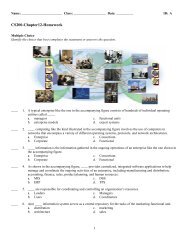
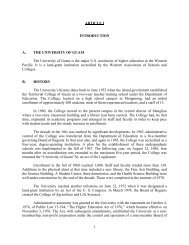
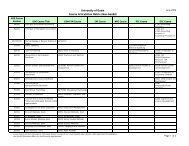
![Modern compiler design [PDF]](https://img.yumpu.com/37285279/1/190x245/modern-compiler-design-pdf.jpg?quality=85)
